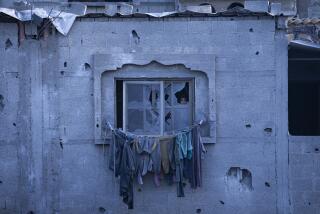Sunrise, and Fighting Shatters Silence in City of the Dead
- Share via
NAJAF, Iraq — It’s 3 a.m. and the only light in the cemetery comes from the illuminated gold dome of the Imam Ali shrine, which radiates in the sky like a midnight sun, casting shadows across thousand-year-old tombs and crypts.
Sitting in his Humvee, Capt. Warren Keahtigh clicks on a blue map-reading light and orders a soldier to cover the windshield with a poncho so enemies won’t detect their position.
Minutes earlier, Keahtigh and about 85 soldiers in his Bravo Company rumbled into the Najaf cemetery, which they’ve dubbed City of the Dead, to relieve another company at what has become one of the toughest fronts in the battle between U.S. troops and a militia led by Shiite Muslim cleric Muqtada Sadr.
Soldiers have come to hate the place.
“It’s a little creepy,” Spc. Chad Mendez says from behind a truck-mounted cannon, scanning the horizon for movement and trying to stay awake.
The bleary-eyed soldiers have taken their positions along a cemetery road and are simply waiting. It’s quiet now. It usually is in the early morning. Sadr’s fighters, soldiers say, are late risers.
But before the end of this eight-hour patrol, two of the company’s soldiers will be sprayed with mortar shrapnel, a massive fire will start a few hundred yards from the mosque and the U.S. military’s Thursday morning assault on Sadr will begin.
With the jumble of tall structures and tombs built just inches apart, the graveyard has become an easy place for fighters of Sadr’s Al Mahdi militia to hide. In five-man squads, the fighters sneak silently among the graves and launch attacks with rocket-propelled grenades, guns and mortars. Then they slip back into the maze or run back to the mosque compound. U.S. troops are loath to follow them, fearing damage to the shrine or backlash from Shiite Muslims over one of their most sacred graveyards.
“It’s hard to fight when you can’t shoot at things,” Keahtigh says.
Four U.S. troops have died in the cemetery since fighting began there more than a week ago.
Some militia members are holing up inside the mausoleums or underground crypts, storing their weapons in coffins and hanging posters of Sadr on the walls. A militia fighter apparently was forced to flee one tomb in a hurry, leaving behind drying laundry, a blanket and a pan of fried meat.
For Keahtigh, 32, a solidly built company commander who affectionately calls his men “knuckleheads,” fighting atop graves is particularly disturbing.
“You don’t mess with people’s graves,” Keahtigh says. “It doesn’t feel right walking on graves. We don’t want to be here, but we don’t have any choice.”
Even the nighttime glow of the mosque is lost on the soldiers. Through their night-vision goggles, the dome appears as a yellow-green sunspot, an intense blotch that hurts their eyes.
Sunrise transforms the cemetery. The forlorn, mystical quality fades, replaced by a harsh light that reveals battle-scarred tombs, piles of twisted metal, trash and U.S. military vehicles lined up along the cemetery road.
The soldiers turn to small talk: Laundry, USC football, where to find the best jambalaya. A couple of guys nod off.
Then rocket-propelled grenades and mortar shells explode. Soon bullets whiz by.
There is more action this morning because another Army unit is moving for the first time to attack the southern edge of Najaf. That appears to be pushing Sadr’s followers north, where they are running smack into Bravo Company.
One of the mortar shells explodes less than 50 yards from Keahtigh, hitting a Humvee. Shrapnel hits its gunner in the face, and another soldier is wounded in the arm.
“We’ve got casualties,” the driver shouts, speeding toward Keahtigh’s truck with the two injured men. A grim-faced Keahtigh runs to the Humvee, looks at the bloodied soldiers and orders them evacuated.
Keahtigh says one of the hardest parts of being a commander is seeing a wounded soldier. “I know something about each of these guys,” he says. “They’re my boys.”
He picks up his radio. “One of our guys has been hit with mortar. Feel free to engage.”
For the next hour, U.S. troops strike back hard. Helicopters swoop down over the graves, firing rockets and spraying with machine guns.
One rocket hits a truckload of suspected Al Mahdi fighters, sparking a blaze that can be seen for miles. At 400 to 500 yards from the mosque, the airstrike is among the closest ever made around the shrine compound.
A gunner catches sight of an Al Mahdi squad running parallel to the road among the tombs. He lets loose with his cannon. Then, one after another, each gunner in the row of military vehicles fires his weapon, as the soldiers chase the fighters through the cemetery.
In the end, a tank commander believes that he has located a militia squad holed up in a mausoleum. He fires a round into the building, and it collapses in white smoke.
By noon, Keahtigh turns over the fight to a new company commander and begins leading his soldiers back to base.
“Did that get hairy, or what?” Keahtigh says. “Oh well, another day, another dollar. I’m going to check on my boys.”
More to Read
Sign up for Essential California
The most important California stories and recommendations in your inbox every morning.
You may occasionally receive promotional content from the Los Angeles Times.












